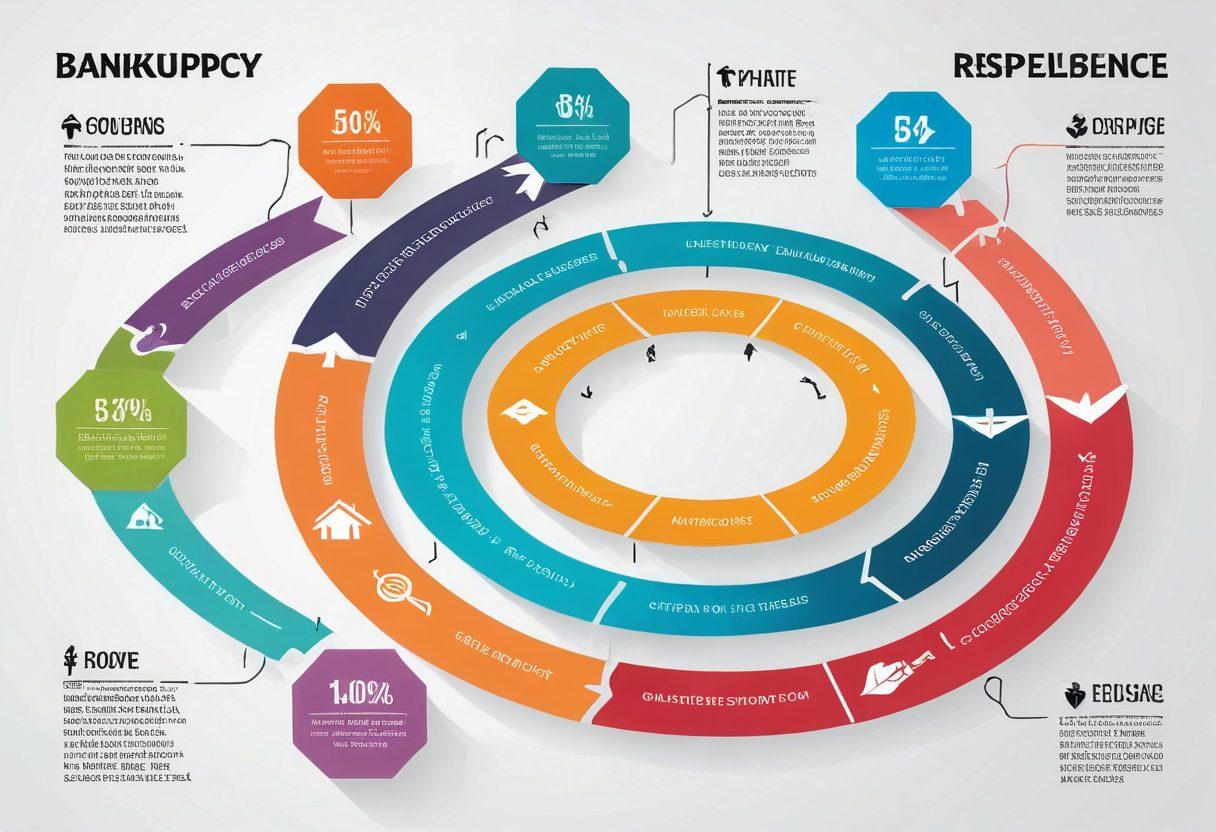Navigating Bankruptcy: Your Essential Guide to Chapter 7 and Chapter 13 Proceedings
In the labyrinthine world of financial struggles, the term 'bankruptcy' often seems like a dark cloud looming overhead. Yet, in the United States, navigating through bankruptcy law can actually illuminate a path toward financial recovery. Imagine feeling the weight of insurmountable debt lift off your shoulders; that’s the promise of a well-executed bankruptcy process. But how do you decide which path to take—Chapter 7 filing or Chapter 13 repayment? This blog is designed to decode the complexities of these two approaches to help you reclaim your financial future.
When facing financial distress, individuals and businesses alike may find themselves eyeing bankruptcy as a potential solution. In essence, bankruptcy acts as a protective shield against creditors. Chapter 7 bankruptcy, often referred to as a 'liquidation bankruptcy,' allows for the discharge of most unsecured debts, effectively providing immediate debt relief. Alternatively, Chapter 13 entails a court-sanctioned repayment plan that allows you to settle debts while keeping your assets intact. The courtroom can feel intimidating, but knowing the differences between these two options can turn the court system from a source of anxiety into a beacon of hope. Remember what financial guru Dave Ramsey famously said: 'You must gain control over your money, or the lack of it will forever control you.'
So, what should you consider when choosing between Chapter 7 and Chapter 13? First, assess your current financial situation. Are your debts primarily unsecured, such as credit card bills or medical expenses? If yes, a Chapter 7 filing could be your best bet for swift debt settlement. However, if you have a stable income and want to keep your property, Chapter 13 repayment might be more suitable. But don’t fret; this isn’t a decision to make alone. The advice of an experienced bankruptcy lawyer can be invaluable during this critical juncture. What’s better than having a legal support system that understands the nuances of bankruptcy guidelines?
Furthermore, it's essential to grasp the significance of the bankruptcy petition and how insolvency proceedings unfold. A bankruptcy petition essentially kicks off the legal proceedings, which include filing necessary documents with the court docket detailing your financial situation. Afterward, whether you’re opting for Chapter 7 or Chapter 13, you will undergo credit counseling—this is both a requirement and a wise step toward responsible debt management. After all, understanding your debts is crucial, as the insights you gain can help you avoid falling back into financial distress.
Lastly, remember that declaring personal bankruptcy isn't the end but rather a turnaround in your financial journey. Embracing credit relief through bankruptcy may feel daunting, but it opens doors for new beginnings. Whether you are leaning towards Chapter 7 or Chapter 13, prioritizing your financial wellness is key. As you embark on this journey, remind yourself that every financial setback can serve as a lesson, leading to improved financial decisions in the future. Are you ready to utilize today's financial challenges as stepping stones to a brighter tomorrow? With the right guidance, your path to financial freedom is not just a dream; it’s a tangible reality waiting to be realized.
Step-by-Step Through Bankruptcy Proceedings: From Filing to Financial Recovery
Navigating the intricacies of bankruptcy law can be likened to traversing a labyrinth filled with unexpected turns and daunting walls. For many facing financial distress, the decision to file can feel overwhelmingly complex. As you embark on this journey, whether through a Chapter 7 filing or a Chapter 13 repayment plan, understanding each step of the legal proceedings is vital. What does it truly mean to reclaim your financial life? Let’s explore this together, offering a roadmap from the initial bankruptcy petition to the hopeful shores of financial recovery.
The first step most people take when they find themselves drowning in debt is to seek out a bankruptcy lawyer. This legal support can be instrumental, as navigating the court system alone can be fraught with unnecessary missteps. Think of your bankruptcy lawyer as your guide—someone who knows the ins and outs of United States bankruptcy guidelines and can help ensure that your bankruptcy petition is filed accurately. Have you ever wondered how a seasoned professional can turn an overwhelming process into a manageable journey? Well, their expertise can provide that clarity you desperately need.
Once you've secured a trustworthy bankruptcy lawyer, the next step often involves credit counseling. This isn't just a formality but a crucial part of the process meant to bring about debt management strategies that may prevent a future recurrence of insolvency proceedings. As you sit in those counseling sessions, reflect on your spending habits—what can you do differently to avoid falling back into the pit of financial distress? The insights garnered could not only breathe life into your bankruptcy case but offer invaluable lessons moving forward.
As your case meanders through the court docket, it’s essential to remain engaged and proactive. Whether you’re pursuing a Chapter 7 filing, which liquidates non-exempt assets to pay off debts, or opting for a Chapter 13 repayment plan that allows you to keep your property while repaying debts over time, understanding each process’s intricacies is crucial. Have you thought about how these choices impact your future credit relief? Your decisions now will echo loudly in your financial future, shaping your credit profile for years to come.
In the end, emerging from bankruptcy is not merely about clearing debts; it's about reclaiming a sense of financial empowerment and stability. The road to financial recovery is paved with lessons learned and protected by careful planning with professional guidance. Remember, bankruptcy isn’t the end of the road; it’s a new beginning. Taking advantage of debt settlement options and maintaining a responsible financial plan will be paramount as you step into this new chapter of your life. How will you rewrite your financial story?
Navigating Legal Waters: Expert Tips for Your Bankruptcy Journey in the U.S.
Navigating the stormy seas of financial distress can feel like a monumental task, especially when the word 'bankruptcy' looms large on the horizon. For many, this daunting journey through the United States bankruptcy court system can appear as intimidating as facing a shipwreck. But fear not; with the right guidance and knowledge, your bankruptcy journey may not be as treacherous as it seems. In this blog, we’ll explore essential tips for navigating the complexities of bankruptcy law, focusing on both Chapter 7 and Chapter 13 procedures to ensure you sail smoothly towards your financial recovery.
Did you know that approximately 800,000 individuals file for personal bankruptcy in the United States each year? That's a staggering number that reflects the ongoing struggles with financial management and the realities of debt settlement. Whether you find yourself wrestling with a mountain of unpaid bills or unexpected expenses, understanding the bankruptcy guidelines can be your lifeline. In this blog, we’ll break down what you need to consider when addressing your bankruptcy petition and how to find the right legal support to tackle insolvency proceedings effectively. Remember: seeking bankruptcy help is not a sign of failure; it’s a strategic step towards financial revitalization.
As you embark on your bankruptcy journey, asking yourself, “What’s the best direction for my financial future?” is crucial. For many, choosing between a Chapter 7 filing and a Chapter 13 repayment plan becomes the compass guiding them through legal proceedings. Chapter 7 is often likened to a fresh start, allowing individuals to eliminate most unsecured debts in exchange for liquidating some assets. On the other hand, Chapter 13 is more about restructuring; it's an opportunity to devise a repayment plan that allows you to keep assets while paying creditors over a period of time. Which path resonates with you? Understanding these differences can significantly impact your approach to debt management and your future credit relief prospects.
When you find yourself knee-deep in the court docket of bankruptcy cases, remember; you don’t have to navigate these waters alone. Enlisting the assistance of a qualified bankruptcy lawyer can make the process smoother and less intimidating. They will ensure that you complete your bankruptcy filing correctly and guide you through the legal intricacies of your situation. Additionally, don’t underestimate the value of credit counseling during this time. Not only can it provide you with invaluable insights into managing your debts, but it can also help you build a budget that aligns with your new financial reality. Partnerships matter, and with expert legal support, you’re more than capable of charting a course for success.
Ultimately, the journey through bankruptcy is also about embracing the lessons learned along the way. Financial distress is daunting, but it often offers the opportunity for growth and renewal. Whether you're aiming for corporate bankruptcy or personal bankruptcy, it's essential to approach this experience with a mindset focused on rebuilding and recovery. With the right resources, support systems, and determination, you have the power to emerge from this legal storm wiser, more knowledgeable, and ready to reclaim your financial status. So, are you ready to navigate through the legal waters of bankruptcy and steer your financial future in a new and prosperous direction?


